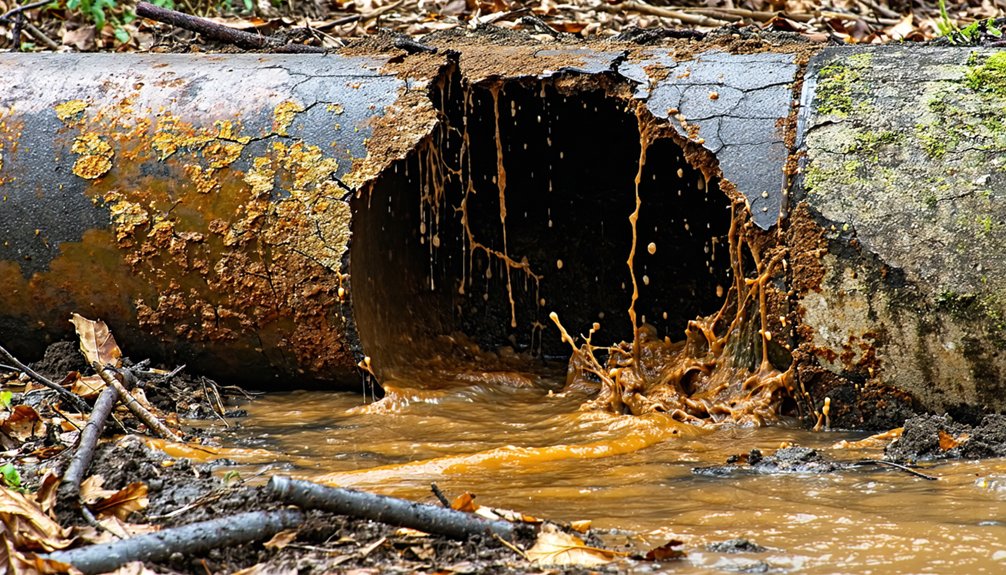Identifying signs of a damaged sewer line is essential for home maintenance. Common indicators include foul sewer smells, slow draining across multiple fixtures, gurgling sounds from toilets, and green patches in the lawn. Frequent sewage backups in drains signify urgent issues. Ignoring these signs can lead to health hazards, structural damage, and costly repairs. Homeowners should seek professional solutions for effective diagnosis and repairs. More effective methods for addressing these issues can be explored further.
Common Signs of a Damaged Sewer Line
A damaged sewer line can present several alarming indicators that homeowners should recognize. Foul smells, particularly sewer odors, often suggest leaks that may pose health hazards requiring immediate attention. Additionally, slow drains across multiple fixtures can signal a serious underlying issue linked to a broken sewer line. Unusual sounds, such as a gurgling toilet, may indicate trapped air stemming from blockages or breaks within the system. Homeowners should also be aware of green patches in their lawn, which can indicate sewage leaks acting as a natural fertilizer. Frequent sewage backups in toilets or drains are unmistakable signs of a clogged drain or broken sewer line that necessitates urgent professional help. Recognizing these signs is vital for homeowners aiming to maintain a safe and functional plumbing system, preventing further complications or extensive damage.
Consequences of Ignoring Sewer Line Issues
Ignoring sewer line issues can trigger a cascade of severe consequences that extend beyond immediate plumbing failures. Homeowners who neglect signs of a damaged sewer line may face significant risks, including health issues and structural damage.
- Health Hazards: Foul odors and plumbing problems can lead to mold and mildew growth, exposing inhabitants to harmful conditions.
- Structural Damage: Long-term neglect can result in foundation cracks and soil erosion, necessitating expensive repairs that diminish property value.
- Financial Burden: Sewage backups and blockages can incur cleanup costs ranging from $1,000 to $25,000, along with the potential need to contact a plumber for urgent repairs.
Thus, timely intervention is essential in mitigating these risks, to avoid exacerbating conditions that can threaten both health and property integrity. Ignoring these signs can lead to a cycle of deterioration that is both costly and preventable.
Professional Solutions for Sewer Line Repair
Prompt attention to sewer line issues leads homeowners to contemplate professional solutions for repair. Licensed plumbers deploy advanced techniques, including camera inspections, to pinpoint the signs of a broken sewer line accurately. Such assessments help determine the extent of plumbing issues, especially those caused by invasive tree roots or other serious problems within the sewer system.
| Key Service | Description |
|---|---|
| Camera Inspection | Utilizes advanced technology to identify damage. |
| Trenchless Repair | Minimizes disruption while effectively repairing lines. |
| Transparent Pricing | Offers clear cost estimates, ranging from $1,000 to $25,000. |
Timely intervention is essential to repair the sewer line, preventing further complications and potential structural damage. Many plumbing companies also provide warranty options, ensuring homeowners are informed and protected throughout the repair process.
Frequently Asked Questions
How to Tell if Your Sewer Line Is Damaged?
Determining if a sewer line is damaged involves examining various symptoms and warning signs. Common indicators include sewage odor detection and unusual drainage patterns that suggest blockages. Water backup issues may arise due to root intrusion effects or pipe corrosion indicators. Additionally, soil settlement signs, such as cracks in structures, can signal serious problems. Plumbing age factors play a role, as older systems are more susceptible to tree root invasions and subsequent damage.
Is Sewer Line Damage Covered by Homeowners Insurance?
Home insurance coverage for sewer line damage varies notably, often subject to specific policy details and coverage limits. Exclusions apply, particularly for preventable damage types. The claim process may necessitate maintenance records, underscoring the significance of preventive measures. Homeowners should consult their insurance provider to clarify repair costs and coverage options, including potential endorsements for sewer backup. Understanding these factors is essential for managing insurance claims related to sewer line incidents effectively.
How Much Does It Cost for a Plumber to Unclog a Sewer Line?
In the world of plumbing, unclogging a sewer line can feel like maneuvering through a labyrinth. Plumber rates typically range from $100 to $500, influenced by the severity of drainage issues. A cost breakdown reveals that basic sewer cleaning may incur flat fees, while emergency services can escalate quickly. For thorough pipe inspections, additional charges of $100 to $300 apply. Regular maintenance tips, including service warranties, can help mitigate future costs with local plumbers.
How to Find a Broken Sewer Line?
To locate a broken sewer line, a thorough sewer line inspection using a plumbing camera is essential. This technology identifies issues like root intrusion or blockages. Homeowners should watch for warning signs such as sewage backups and slow drains. While DIY repairs may be attempted, a professional assessment is often necessary. Excavation costs can be significant, so implementing pipeline maintenance and preventative measures is advisable to avoid future complications.



